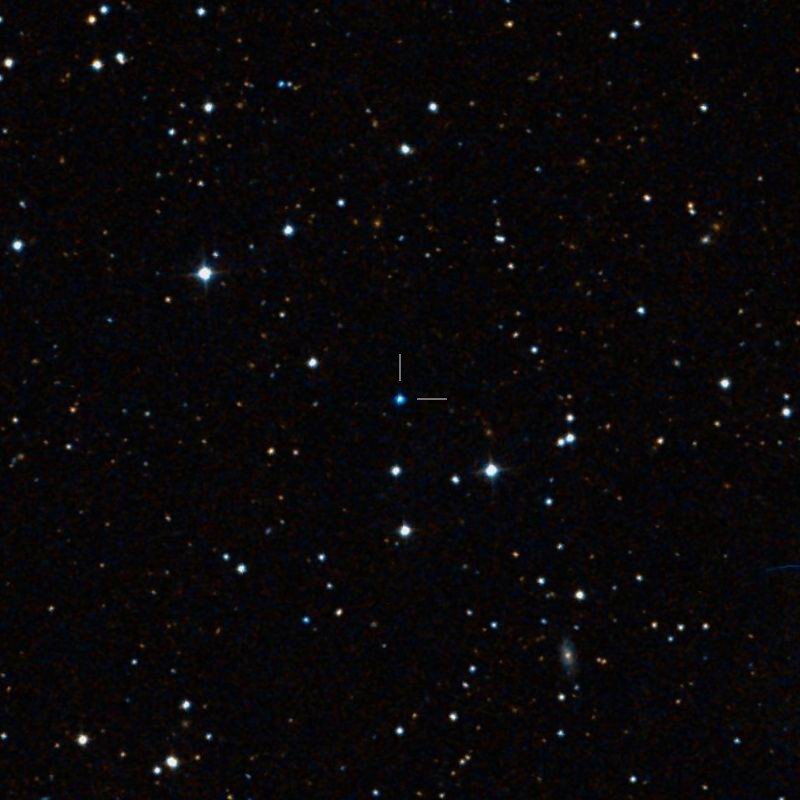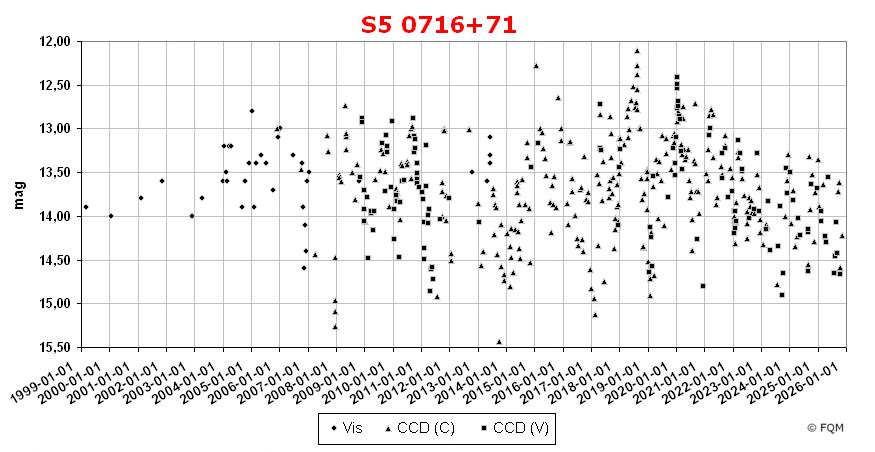
| Frankfurt Quasar Monitoring |
| S5 0716+71 |
| Cross-Identifications | TXS 0716+714, S5 0716+714, RGB J0721+713 IRAS F07162+7126, 2MASS J07215342+7120362 1RXS J072153.2+712031, WMAP J0721+7122 GALEXASC J072153.36+712036.2, 0716+71 87GB 071611.1+712619, GB6 J0721+7120 1WGA J0721.8+7120, 2EG J0720+7126 RX J0721.8+7120, 1FGL J0721.9+7120 8C 0716+714, 1H 0717+714, 2E 1802 GEV J0719+7133, EGRET J0720+71 |
| Equat. coordinates | RA 07 21 53.3 DE +71 20 36 (J2000) |
| Constellation | Camelopardalis |
| Type | BL Lac |
| Redshift |
z=0.300 (2) / z=0.310 (5) |
| Distance (2) (3) |
1153 Mpc |
| Total mag range (mv) (4) | 12.06 - 17.5 |
| Catalog Magnitude (1) | 15.50 |
| Absolute Magnitude (1) | --- Mpc |
| Light Travel-Time (2) | 3.299 × 109 yrs |

Comparison stars
| star | B | V | Rc |
| 1 | 12.02 (0.01) |
11.46 (0.01) |
11.12 (0.01) |
| 2 | 13.04 (0.01) |
12.43 (0.02) |
12.06 (0.01) |
| 3 | 13.66 (0.01) | 13.19 (0.02) |
12.89 (0.01) |
| 4 | 14.15 (0.01) |
13.55 (0.02) |
13.18 (0.01) |
| 5 | 14.24 (0.01) |
13.63 (0.02) |
13.26 (0.01) |
| 6 | 14.55 (0.01) | 13.74 (0.02) |
13.32 (0.01) |
| 7 | 14.70 (0.01) |
14.10 (0.02) |
13.79 (0.02) |
| 8 | 15.685 (0.012) |
15.025 (0.009) | 14.654 (0.001) |
| 9 | 16.097 (0.015) |
15.550 (0.011) |
15.087 (0.012) |
| 10 | 16.621 (0.008) |
16.028 (0.013) |
15.653 (0.023) |


| S5
0716+71 is a bright and violently variable BL Lac object
in Camelopardalis. Its position lies about 3.4° NE of star 43 Cam, and
2.2° N of irregular galaxy NGC 2366. S5 0716+71 was discovered as a
radio source in 1977/78 during the 5 Ghz Strong Source Survey (S5).
Follow-up spectroscopy clearly identified S5:0716+71
as a quasi-stellar object. Today, S5 0716+71 is classified as a BL Lac
object due to its (nearly) featureless spectrum, rapid variability and
strong optical polarization. The first accurate redshift measurement
for
S5 0716+71
was published in 2008. Besides the optical and radio, this
blazar has been kown also as an emitter
of infrared (IRAS), X-ray (1RXS, 1H) and even gamma
(TeV) emissions (2EG, GEV, EGRET). The
host galaxy itself has an apparent diameter of 5.4 arcsecs,
which corresponds to a true size of only about
12 kpc. Blazar S5 0716+71 is a violently variable object with a total optical range of more than 5 magnitudes! An exceptionally bright state in the optical was reported in January 2015, when the blazar reached 12.06 mv - the brightest magnitude for this object ever recorded. On average, brightness varies between 13 mag and 14 mag. Due to its exceptional brightness, this blazar is an easy task for visual observers with telescopes of 8- to 10-inch of aperture, at maximum even for 6-inch telescopes. The object appears stellar even with large apertures. Without a go-to mount, tracking down blazar S5 0716+71 may become a little tricky as it lies in a region lack of brighter stars for easy starhopping. Both CCD observers and visual observers shall use the comparison stars given above. The comparison stars 4=13.55mv and 5=13.63mv are recommended for both unfiltered and v-mag photometry. Another photometric sequence was published by Nesci et al. (2005). Note: The data point of 12.27CV in the light curve above was CCD imaged by Manfred Mrotzek (Ger) on Jan. 17, 2015, 23:10UTC. Manfred kindly provided his images for photometric reduction, carried out by the author. ____________
When you are around for S5
0716+71,
do not forget to visit the
irregular galaxy
NGC 2366 only
2.2° S,
a low
surface brightness galaxy and
member of the M 81-galaxy group. Far beyond the M 81-galaxy group, and some 5° SW of S5 0716+71, another quasar is ready to be observed: HS 0624+6907. This is a bright 14-mag object at a distance of about 3.9×109 light-years. |
| Biermann, P., Duerbeck, H., et al. 1981, ApJ, 247, L53; Observations of six Flat Spectrum Sources from the 5 GHz Survey. Gonzàlez-Pérez, J.N., et al. 2001, AJ, 122, 2055; Optical and Near-Infrared Calibration of AGN field stars: An All-Sky Network of faint stars calibrated on the Landolt System. Karge, S.; Helle Quasare für 8- bis 10-Zoll Teleskope. Ein Beobachtungsführer zur visuellen Beobachtung von Quasaren und BL Lacertae Objekten; Frankfurt 2005. Katajainen, S., Takalo, L.O., et al. 2000, A&AS, 143, 357; Tuorla Quasar Monitoring. I. Observations of 1995-1997. Kühr, H., Johnston, K.J., et al. 1987, A&AS, 71, 493; Optical Identifications and Radio Morphology of the complete 5 Ghz S5 Survey. Kühr, H., Pauliny-Toth, I.I.K., Witzel, A., Schmidt, J. 1981, AJ, 86, 854; The 5-Ghz Strong Source Survey. V. Survey of the area between Declinations 70° and 90°. Nesci, R., Massaro, E., et al. 2005, AJ, 130, 1466; The long-term optical Variability of the BL Lacertae Object S5 0716+71: Evidence for a Precessing Jet. Nilsson, K., Pursimo, T., et al. 2008, A&A, 487, L29; Detection of the host galaxy of S5 0716+714. Raiteri, C.M, Villata, M., et al. 2003, A&A, 402, 151; Optical and Radio Behaviour of the BL Lacertae Object 0716+714. Rector, T.A., Stocke, J.T. 2001, AJ, 122, 565; The Properties of the Radio-Selected 1 Jy Sample of BL Lacertae Objects. Steinicke, W.; Beobachtungsliste für helle Quasare; Umkirch 1999. Véron-Cetty, M.-P., Véron, P. 2001, A&A 374, 92; A Catalogue of Quasars and Active Nuclei: 10th edition. Véron-Cetty, M.-P., Véron, P. 2003, A&A 412, 399; A Catalogue of Quasars and Active Nuclei: 11th edition. Véron-Cetty, M.-P., Véron, P. 2006, A&A 455, 776; A Catalogue of Quasars and Active Nuclei: 12th edition. Véron-Cetty, M.-P., Véron, P. 2010, A&A 518, 10; A Catalogue of Quasars and Active Nuclei: 13th edition. Villata, M., Raiteri, C.M., et al. 1998, A&AS, 130, 305; BVR Photometry of Comparison Stars in selected Blazar Fields, I: Photometric Sequences for 10 BL Lacertae Objects. Wenzel, K. 2003, SuW 2/03, 60; BL-Lacertae-Objekte. Wenzel, K. 2005, Interstellarum 38, 54; BL Lacertae-Objekte. Eine visuelle Langzeit-Überwachung. Witzel, A., Schalinski, C.J., et al. 1988, A&A, 206, 245; The Occurrence of Bulk Relativistic Motion in Compact Radio Sources. |
| Links: Landessternwarte Heidelberg Hamburg Quasar Monitoring Chara/PEGA Gary Poyner (light curve) ATel #6953 / ATel #6962 (Optical Max. in 1/2015) AAVSO |
| home |